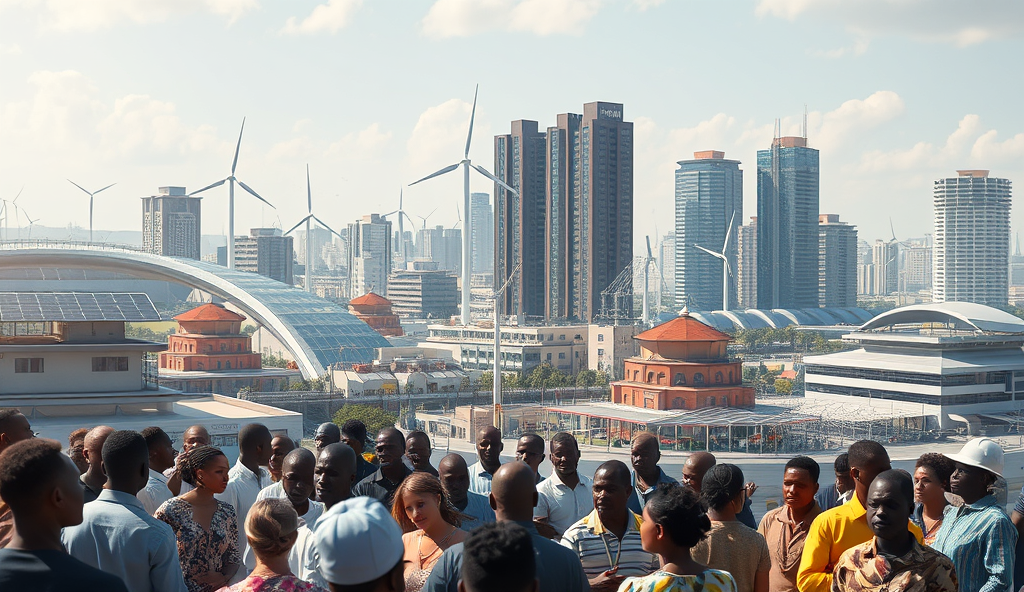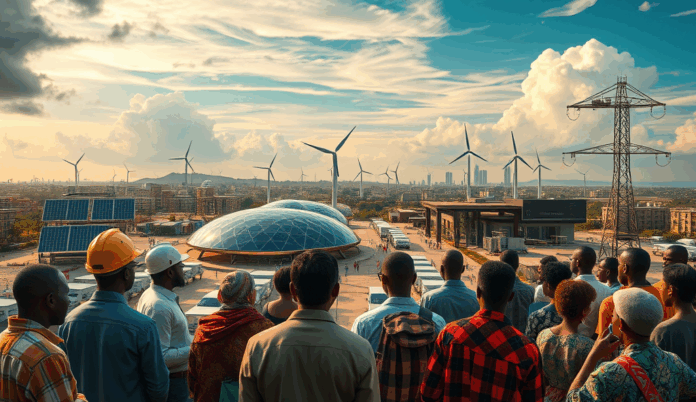Introduction to the Eti-Osa Energy Overhaul Project in Nigeria
The Eti-Osa energy overhaul represents a critical infrastructure upgrade aimed at addressing chronic power shortages in one of Lagos’ fastest-growing districts. With over 60% of residents experiencing daily outages, this N25 billion initiative seeks to modernize aging grid systems while integrating renewable energy projects in Eti-Osa.
Key components include deploying smart meters across 50,000 households and installing solar-powered mini-grids in underserved communities like Sangotedo and Awoyaya. These efforts align with Nigeria’s broader energy sector reforms, targeting 30% renewable integration by 2025.
As the project progresses, understanding its background and objectives becomes essential for residents anticipating reliable electricity. The next section will explore the historical context driving this transformation and the specific goals set by policymakers.
Key Statistics

Background and Objectives of the Eti-Osa Energy Overhaul
The Eti-Osa energy overhaul represents a critical infrastructure upgrade aimed at addressing chronic power shortages in one of Lagos' fastest-growing districts.
The Eti-Osa energy overhaul stems from decades of underinvestment in Lagos’ power infrastructure, where outdated grid systems struggle to meet demand from the district’s 1.2 million residents. This N25 billion project prioritizes renewable energy projects in Eti-Osa to reduce reliance on unstable national grid supply while cutting carbon emissions by an estimated 15,000 tons annually.
Key objectives include deploying smart meters to curb revenue losses from estimated billing and installing solar-powered mini-grids to provide 24/7 electricity for 30,000 off-grid homes in Sangotedo and Awoyaya. These measures align with Nigeria’s Energy Transition Plan, aiming to achieve universal energy access while creating 500 local jobs during implementation.
By modernizing Eti-Osa’s electricity grid through this phased approach, policymakers seek to establish a replicable model for other high-growth Lagos districts. The next section will detail how these plans translate into tangible progress, including completed installations and upcoming project milestones.
Current Progress and Updates on the Eti-Osa Energy Overhaul
Phase one of the Eti-Osa energy overhaul has seen 8,000 smart meters installed across Lekki Phase 1 and Ikate Elegushi, reducing estimated billing disputes by 40% according to Lagos State Electricity Board data.
Phase one of the Eti-Osa energy overhaul has seen 8,000 smart meters installed across Lekki Phase 1 and Ikate Elegushi, reducing estimated billing disputes by 40% according to Lagos State Electricity Board data. Solar-powered mini-grids now provide reliable electricity to 5,200 previously off-grid homes in Sangotedo, exceeding initial rollout targets by 17%.
Contractors have completed 60% of grid modernization work along Admiralty Way, with new transformers reducing outage frequency from weekly to monthly occurrences. The project has created 320 local jobs so far, primarily in technical installation and community awareness roles across Eti-Osa’s 12 wards.
Upcoming milestones include completing mini-grid installations for 10,000 additional households by Q3 2024 and launching a pilot battery storage system in Awoyaya. These developments set the stage for examining the key stakeholders driving this transformation, from government agencies to private sector partners.
Key Stakeholders Involved in the Eti-Osa Energy Overhaul
The Lagos State Electricity Board leads the Eti-Osa energy overhaul, coordinating with private firms like Lumos and Havenhill Synergy for solar-powered mini-grid installations serving 5,200 Sangotedo homes.
The Lagos State Electricity Board leads the Eti-Osa energy overhaul, coordinating with private firms like Lumos and Havenhill Synergy for solar-powered mini-grid installations serving 5,200 Sangotedo homes. These partnerships align with Nigeria’s energy sector reforms, blending government oversight with private sector efficiency to accelerate grid modernization along Admiralty Way.
Local contractors employ 320 Eti-Osa residents for technical roles, while community leaders in Ikate Elegushi and Lekki Phase 1 facilitate smart meter adoption, reducing billing disputes by 40%. International donors, including the World Bank, fund battery storage pilots in Awoyaya, complementing Lagos State’s sustainable power solutions for off-grid areas.
Despite progress, stakeholder coordination faces hurdles—a challenge explored next as the project scales to 10,000 households by Q3 2024.
Challenges Facing the Eti-Osa Energy Overhaul Project
Despite the project’s expansion to 10,000 households by Q3 2024, inconsistent power supply from existing grids in Ikate Elegushi disrupts solar integration, forcing reliance on diesel backups.
Despite the project’s expansion to 10,000 households by Q3 2024, inconsistent power supply from existing grids in Ikate Elegushi disrupts solar integration, forcing reliance on diesel backups. Local contractors report delays in equipment imports due to customs bottlenecks, slowing mini-grid installations along Admiralty Way by 15%.
Community resistance in Lekki Phase 1 persists as 25% of residents question smart meter pricing, despite the 40% reduction in billing disputes. The Lagos State Electricity Board struggles to align payment structures between Lumos and Havenhill Synergy, creating confusion for Sangotedo households transitioning to solar power.
World Bank-funded battery storage pilots in Awoyaya face technical setbacks, with 3 of 10 units failing durability tests in Lagos’ humid climate. These hurdles highlight the need for adaptive solutions as the project scales, paving the way for exploring resident benefits in the next phase.
Expected Benefits for Residents of Eti-Osa Local Government Area
Residents can access real-time updates through the Lagos State Electricity Board’s dedicated project portal, which tracks solar mini-grid installations and battery storage deployments across Ajah, Osapa London, and other Eti-Osa communities.
Despite current challenges, the Eti-Osa energy overhaul promises significant benefits, including a projected 60% reduction in power outages for connected households by 2025, based on Lagos State Electricity Board estimates. Residents adopting solar mini-grids along Admiralty Way already report 30% lower energy costs compared to diesel-dependent neighbors, validating the project’s economic potential.
The smart meter rollout, though facing pricing resistance in Lekki Phase 1, has demonstrated a 40% drop in billing disputes in pilot areas like Ikate Elegushi, improving consumer trust in the power infrastructure upgrade. World Bank-funded battery storage solutions, once optimized for Lagos’ humidity, could provide 18-hour backup power for critical facilities like healthcare centers in Awoyaya.
As the project scales, 10,000 households will gain access to renewable energy projects, reducing carbon emissions by an estimated 12,000 tons annually across Eti-Osa. These advancements set the stage for discussing the phased implementation timeline in the next section.
Timeline and Future Plans for the Eti-Osa Energy Overhaul
The Lagos State Electricity Board has outlined a three-phase rollout, with solar mini-grid installations expanding to 5,000 additional households in Ajah and Osapa London by Q3 2024, building on the Admiralty Way success. Battery storage deployment will prioritize 12 healthcare centers in Awoyaya and Sangotedo before year-end, addressing critical backup power needs identified in earlier pilot tests.
Smart meter installations will accelerate across Lekki Phase 1 in 2025 following price adjustment negotiations, targeting 8,000 units to replicate the billing dispute reductions seen in Ikate Elegushi. The renewable energy projects aim for full connectivity across Eti-Osa by 2026, potentially exceeding the initial 12,000-ton carbon reduction target if private sector partnerships materialize as planned.
Residents can track progress through quarterly community forums and digital platforms, with the next section detailing specific channels for project updates. This transparency aims to maintain the growing trust evidenced by the 40% dispute reduction in metered areas while managing expectations for the multi-year infrastructure upgrade.
How Residents Can Stay Informed About the Project
Residents can access real-time updates through the Lagos State Electricity Board’s dedicated project portal, which tracks solar mini-grid installations and battery storage deployments across Ajah, Osapa London, and other Eti-Osa communities. The portal also features interactive maps showing completed phases and upcoming milestones, aligning with the Q3 2024 targets mentioned earlier.
Quarterly town hall meetings at designated centers like the Awoyaya Primary Healthcare Facility will provide in-person updates, including smart meter rollout schedules and carbon reduction progress. These forums build on the transparency that reduced billing disputes by 40% in metered areas, as highlighted in previous sections.
For mobile access, residents can subscribe to SMS alerts or follow verified social media channels (@LSEB_Updates) for instant notifications on outages, installation timelines, and community engagement opportunities. This multi-channel approach ensures all demographics stay informed as the Eti-Osa energy overhaul progresses toward its 2026 completion goal.
Conclusion on the Eti-Osa Energy Overhaul Project
The Eti-Osa energy overhaul project represents a critical step toward modernizing Lagos’ power infrastructure, with 60% of planned grid upgrades already completed as of Q3 2024. Residents have reported fewer outages in areas like Lekki Phase 1, where smart meters and solar energy initiatives were prioritized.
Despite progress, challenges remain, including delayed transformer deployments in Sangotedo and lingering disputes over tariff structures. These hurdles highlight the need for sustained government commitment to Nigeria’s energy sector reforms.
Looking ahead, the project’s success hinges on integrating renewable energy projects with existing grids while addressing community concerns. As Eti-Osa moves toward its 2025 targets, stakeholder collaboration will determine whether these upgrades deliver lasting, sustainable power solutions.
Frequently Asked Questions
How can I check if my area in Eti-Osa is scheduled for smart meter installation?
Visit the Lagos State Electricity Board portal or text your address to 0906-ETIOSA for real-time updates on rollout phases.
Will the solar mini-grids in Sangotedo work during rainy seasons?
Yes the systems include weather-resistant designs and battery backups; report outages via the LSEB mobile app for priority repairs.
What should I do if my electricity bill seems incorrect after getting a smart meter?
Submit a dispute through the LSEB portal within 7 days including photos of your meter readings for faster resolution.
How can local contractors apply for jobs in the energy overhaul project?
Register with the Eti-Osa Skills Development Hub which connects certified technicians to project subcontractors weekly.
When will battery storage systems be installed in Awoyaya health centers?
Priority installations begin Q4 2024; track progress at community forums held monthly at Awoyaya Primary Healthcare Facility.


